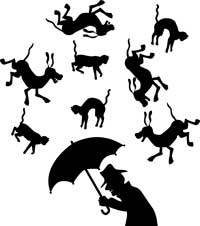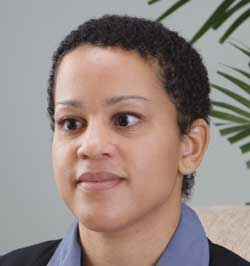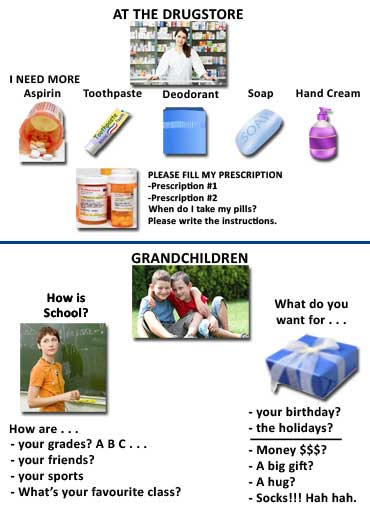Impairments of Language
 Aphasia is the loss or reduction of language resulting from brain
damage. It can involve both the expression and understanding of language, and affect speech, writing and gestures. The severity depends on the part of the brain injured and the size of the injury. Some people may experience equal difficulty across
all language areas, while others may have more severe problems in one or more areas. A stroke is the most common cause of aphasia.
Aphasia is the loss or reduction of language resulting from brain
damage. It can involve both the expression and understanding of language, and affect speech, writing and gestures. The severity depends on the part of the brain injured and the size of the injury. Some people may experience equal difficulty across
all language areas, while others may have more severe problems in one or more areas. A stroke is the most common cause of aphasia.
Expressive Aphasia
Some people with aphasia have trouble using words and sentences, called expressive aphasia. People with expressive aphasia:
- Speak only in single words (e.g., names of objects), or have no speech with the exception of a few sounds
- Speak in short, fragmented phrases
- Omit smaller words like “the,” “of,” or “and” (making their speech sound like a telegram)
- Put words in wrong order
- Switch sounds and/or words (e.g., bed is called table or a dishwasher a “wish dasher”)
- Make up words
- String together nonsense words and real words fluently
- Have difficulty finding the words they want to use
- Have difficulty starting a conversation
- Have difficulty using humour
An interview with Sarah Scott who has expressive aphasia (Broca’s aphasia):
Receptive Aphasia
 Some people with aphasia have problems understanding others,
a condition known as receptive aphasia. People with receptive aphasia:
Some people with aphasia have problems understanding others,
a condition known as receptive aphasia. People with receptive aphasia:
- Need extra time to understand speech
- Have difficulty following fast speech, lengthy conversations or group discussions in which topics change rapidly
- Easily misinterpret what is said and become frustrated
- Misinterpret subtleties of language
- Take figures of speech literally (e.g., It’s raining cat and dogs)
- Have trouble following instructions when more than one step is presented at a time
- May not be able to follow or may lose interest in television programs and movies
Other Types of Aphasia
Some people with aphasia struggle with both using and understanding words, a condition called mixed aphasia or global aphasia. Typically, reading and writing are more impaired than talking or understanding.
 Caregivers can support individuals with
expressive aphasia by using the following conversational strategies:
Caregivers can support individuals with
expressive aphasia by using the following conversational strategies:
- Try to establish the topic by asking questions (similar to the game Twenty Questions).
- Ask yes/no questions, or give choices. Open-ended questions, which require a long answer, can be difficult.
- Encourage other communication methods, such as pointing, gesturing, using pantomime, drawing or writing part of the word.
- When the individual cannot find the desired word, suggest the substitution of a synonym, an antonym (opposite) or several associated words (e.g., pillow, sleep, sheets = bed) to help you guess the desired word.
- Attempt to cue the person:
- Provide a short description or category name.
- Use a short, open-ended sentence to elicit the word automatically.
- Provide the first sound or syllable.
- Praise all attempts to communicate. Avoid criticism and ignore grammar or pronunciation errors.
- Avoid speaking for the other person without permission.
- Never talk about individuals as if they were not present.
- Give the person your undivided attention.
- Be patient, don’t rush and give the individual plenty of time to communicate a message. If the person’s frustration increases, take a break. Try again when the person is calm.
- If you become frustrated, take a break and calm down. Frustration is contagious and may make it even more difficult for the individual to get their message across.
- If the person has a communication book or an alternative communication device, encourage its use.
 One of the most important communication skills is the ability to answer
yes/no questions consistently and reliably. If a person is not physically or verbally able to answer yes/no questions, alternative ways to respond must be found. Some possible alternative responses include:
One of the most important communication skills is the ability to answer
yes/no questions consistently and reliably. If a person is not physically or verbally able to answer yes/no questions, alternative ways to respond must be found. Some possible alternative responses include:
- Eye gaze – look up for yes and down for no, or look right for yes and left for no.
- Eye blink – blink for yes
- Squeeze your hand for yes
- Head nod for yes
- Point to the printed word for yes and no
- Point to pictures showing a smile and a frown
All communication partners must use the same method when communicating with the person. Provide practice in using the alternative response until the skill becomes natural.
Alphabet and word/picture boards are simple and cost-effective devices for communicating messages.

Individuals who have Parkinson’s disease often speak very rapidly, which can sound mumbled. It is of little benefit to remind these individuals to speak slower, as they have extreme difficulty controlling their rate of speech. Pointing to the first letter of each word as they say it can be helpful, as it forces the person to speak more slowly and also provides listeners with a clue as to what is being said.
As with impairments of speech, some individuals with expressive aphasia can use technology to support communication.
- Augmentative and alternative communication (AAC) can be as simple as a board divided into squares filled with a functional vocabulary of images and/or words that the person points to, or as complex as a keyboard controlled by touch or eye gaze.
- Low-tech strategies for expressing opinions, wishes or feelings can include rating scales, written choice communication and a context-sensitive communication book or board.
Rating scales are useful when asking questions that require an opinion. For example, “How do you think the election is going?” or “How are you feeling?”

A written choice communication strategy can also be used. With this strategy, you present written key-word choices related to a specific topic or question. The person points to the choices, thereby making their opinions and preferences known. Here is an example of a conversation fragment:
Caregiver: Should I take angel food cake, brownies or cookies? [Writes the following:]
Angel Food Cake
Brownies
Cookies
Loved One: (points to Brownies)
Caregiver: Yes, everyone seems to like them. Should I make them from scratch or use a mix?
Scratch
Mix
Loved One: (points to Mix)
 Communication books or boards contain messages that have been
created to help individuals communicate in specific situations. Communication books are usually arranged by categories to help an individual express basic wants and needs, biographical information and social exchanges. The books are usually arranged
by topics such as:
Communication books or boards contain messages that have been
created to help individuals communicate in specific situations. Communication books are usually arranged by categories to help an individual express basic wants and needs, biographical information and social exchanges. The books are usually arranged
by topics such as:
- People
- Places
- Food
- Toiletries
- Calendar
 A community communication aid may be helpful
for people who want to communicate with others outside the home, such as to request items or services in the community, e.g., black coffee with two sugars.
A community communication aid may be helpful
for people who want to communicate with others outside the home, such as to request items or services in the community, e.g., black coffee with two sugars.
Communication boards can be customized for specific situations, such as going to the drugstore, a restaurant or bank. Here is an example of a board which could be used in a drugstore.
Communication boards can also be set up for more general purposes. Here is an example of a topic-based board that could be used in a conversation with the grandchildren. With the use of a digital camera, it is easy to include meaningful pictures on the communication board.
High-tech devices are becoming increasingly more common. A range of devices is available to accommodate varied skills and needs. Some people have good manual dexterity, while others have to use alternatives such as switches, head pointers or eye gaze. Some people can read and spell, while others need communication aids on which language is represented by pictures or photographs.
Some high technology systems generate speech and can be customized to meet an individual’s needs.
Not all individuals will be able to use alternative communication devices or systems because of physical, sensory or cognitive impairments. To use alternative communication devices successfully, the person must be motivated and have a supportive environment.
Caregivers can support individuals with receptive aphasia by using the following conversational strategies:

- Ask the individual what would be helpful and incorporate it into your conversation style.
- Facing the individual and maintaining eye contact helps keep their attention and shows that you are interested in what they have to communicate.
- Speak clearly and at a natural rate. Avoid speaking loudly or too slowly. Insert pauses between sentences and emphasize key words.Use short, simple sentences with words you know they are familiar with. Avoid long, detailed explanations. Explain important information in a series of steps. Watch for signs of confusion or misunderstanding.
- Stick to one topic at a time.
- Write down key points or words if reading ability is better than speech understanding skills. Use pictures, photographs and rating scales to introduce topics or convey information. Add appropriate gestures and facial expressions.
- Do not talk down to the individual or speak as you would to a child. Use a natural, adult-to-adult tone of voice and language.
Some of the same assistive technology devices that support conversation with individuals who have expressive aphasia may be helpful to those with receptive aphasia.